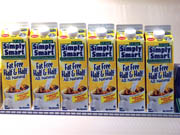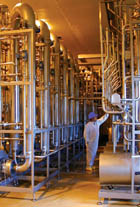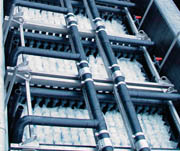
Munir Cheryan of the University of Illinois at Urbana-Champaign was present at the dawn of nanofiltration 20 years ago. Cheryan is a professor of food and biochemical engineering and author of the Ultrafiltration and Microfiltration Handbook, a book cited in scores of US patents involving filtration. Until 1985, "size was everything," the chemical engineer recalls. With nanofiltration, scientists could exploit the ionic charge of compounds of concern by employing membrane polymers that would cause a hydrophilic or hydrophobic reaction. In that way, elements could be passed through or blocked, depending on their desirability.
An early application was Cheryan's process for soybeans. The high quality of soy's protein and fat has made soy a valuable commodity, though some soy compounds are undesirable. Pairing nanofiltration with an appropriate pretreatment allowed him to isolate the good from the bad, an accomplishment that caused processors to beat a path to his door-15 years after the fact, when soy's health claims were approved by FDA. "Sometimes it doesn't pay to be too far ahead of your time," Cheryan laughs.
Membrane surface chemistry gives engineers the ability to manipulate the essence of flavor, color and other aspects of foods. The best may be yet to come, as researchers seek to isolate bioactives, the basis of functional foods, with processes that rely on nanofiltration for initial concentration and chromatography to separate complex mixtures in a stationary phase and a mobile phase in a chromatographic column.
For R&D chemists, those are the challenges that make coming to the lab each morning exciting. "Dairy is old hat," sighs Koseoglu, and sophisticated membranes of a decade ago are now commodities subject to intense price competition-boring for pilot plants, great news for commercial plants.

Brave old world
Even if dairy filtration no longer excites the research community, there is plenty of activity to interest commercial users. Refinements in the technology are part of it, but changes in consumption are a bigger factor.
O-At-Ka Milk Products Cooperative Inc. in Batavia, NY, has applied ultrafiltration processes since the early 1990s, but shifting consumer tastes are expanding the technology's uses. "Now there is value in breaking down serum proteins and other nutritional ingredients for a variety of uses," says Mac McCampbell, the dairy's chief operating officer. Animal feed products, dairy-based liqueurs and meal replacements for special populations are among the possibilities for dairy ingredients through ultrafiltration.
The low-carb diet helped raise interest. Lactose contains the carbohydrates in milk, and separating that component from proteins defies conventional dairy processes. "The low-carb bubble has burst, but it has not gone away," McCampbell points out, and that helps sustain throughput demand for O-At-Ka's two-stage ultrafiltration system. An even bigger market exists for protein concentrates for bodybuilders and fitness aficionados who seek fortified foods. The dairy produces retorted cans with up to 52 grams of protein, with the lactose removed via filtration.
Changing the ratio of lactose and protein also affects milk's affinity to moisture, viscosity and mouthfeel, says McCampbell. "There are some amazing things you can do to the functionality," he says, such as the way high-protein concentrations will whip when making ice cream.

Cold pasteurization of milk through microfiltration is an idea that has intrigued dairy scientists for decades. Researchers at Alfa Laval in Sweden secured a US patent in 1989 for a process that filtered out bacteria and spores, with the retentate then sterilized and added back to the purified milk. German scientists with Biotest Pharma GmbH in 1996 patented a process for sterile filtration of milk by removing calcium ions before filtering out the bacteria to achieve sterilization. The Germans' process incorporated Bactocatch, which studies suggested extended milk's shelf life by 50 percent.
"Ultrafiltration with spiral wound membranes started in the 1960s," Biel says. "It's only been recently that ceramic membranes have been [considered] for dairy." Originally developed by Alfa Laval, Alcross relies on a ceramic membrane with slightly larger pores than ultrafilters so that "everything except the bacteria goes through," he says. "There's a better mouthfeel and taste. In Canada, you're seeing significant market share shifts." Parmalat and Natrel dairies also use the technology. Microfiltered milk now accounts for 10% and 14% of sales in Ontario and Quebec provinces, respectively.
Disposing of the retentate from ultrafiltration and microfiltration can be an issue, though the economics of separation certainly work in the case of cheese whey. Processing whey to a 30 percent protein concentration is five times more energy efficient than using an evaporator, according to Carl Hoffman, who heads the food & beverage segment of Koch Membrane Systems Inc., Wilmington, MA. At higher concentrations, evaporation is more efficient, he concedes, but membrane filters also screen out salt, ash and other elements.
Besides drinking water, dairy is the biggest processing application for filtration, though uses for beer, wine and vinegar are growing, Hoffman says. Wastewater treatment and recovery also is booming, "but people still misunderstand the benefits and economic drivers," he laments. "After we did an audit of the costs and savings for a recovery system for a customer, we were down to a three-and-a-half-year payback. Originally it was five years, so the project wasn't even on the table."
Complicated economics is a bigger barrier to wider filtration applications than technical limitations, concurs Lisa Madsen, technical manager for food & beverage at Pall Corp., East Hills, NY. Like Koch, Pall does a lot of work clarifying beverages-juices in the case of Koch, beer and wine for Pall. The key to expanding filtration's uses lies in a more integrated approach in which filtration complements another process. That explains why Pall is snapping up firms specializing in chromatography for biotech purification. The firm also forged partnerships with GE Water Technology and Westphalia Separator AG, which worked with Pall to develop an alternative to diatomaceous earth for yeast removal in beer and wine ("Filtration's strange bedfellows," Food Engineering, April 2005).
Technological synergism is a necessity to incorporate filtration into the processing of more viscous products. Researchers are focusing on high fructose corn, but corn syrup's viscosity is 10 times greater than Pall's hollow fiber ceramic filters can handle, notes Madsen. Nonetheless, filters can be integrated into initial clarification and points downstream, though it will require rethinking the overall process. "A lot of manufacturers have been doing things the same way for so many years that the knowledge has been lost as to why they are doing it that way," she says.
Greenfield projects and start-up lines provide the best opportunity to reconsider all the steps in a process and how filtration can improve it. Those opportunities are most numerous on the Pacific Rim and in mainland China. An example is Xi'An Jiaoda Qinmei Modern Agriculture Co. Ltd., a kiwi processor that followed the Chinese template of building a plant a few years after intensive planting of raw materials. The company owns 1,647 acres under kiwi cultivation in Shaanxi Province, and its HACCP- and kosher-certified plant processes purees, beverages and other kiwi products.
When it was time to diversify into kiwi concentrate two years ago, the Italian engineering company that designed the plant rethought processes to meet the objective of a high-end finished ingredient. Conventional evaporators subject the juice to temperatures up to 195

Crash course in filtration
Uncertainty and doubt are the byproducts of filtration technology advances. For those in need of some reassurance, the Practical Membrane Technology Short Course next month in suburban Chicago is the place to be.Sefa Koseoglu, a chemical engineer and president of Filtration and Membrane World LLC, organizes a two-day event for food processors who want to make sure they know the technology's essentials before embarking on a project. "They may be about to invest $3 million in a membrane system and want to make sure they aren't missing something," says Koseoglu. " Or they may have an application and need to gain contacts to decide what approach to the market is best."
The course will be held July 14-15 in Des Plaines, IL, immediately north of O'Hare Airport. Information is available at www.membraneworld.com/scusa.htm. This event is co-sponsored by Food Engineering.